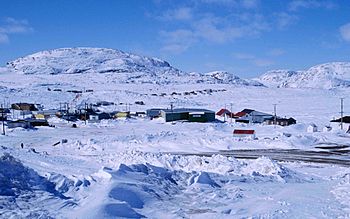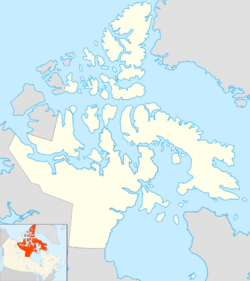Dorset Island facts for kids

Dorset Island's Kinngait Hill and the hamlet of Cape Dorset, 1997
|
|
| Geography | |
|---|---|
| Location | Hudson Strait |
| Coordinates | 64°12′N 76°32′W / 64.200°N 76.533°W |
| Archipelago | Arctic Archipelago |
| Area | 143.48 km2 (55.40 sq mi) |
| Highest elevation | 208 m (682 ft) |
| Highest point | Kingnait Hill |
| Administration | |
|
Canada
|
|
| Territory | Nunavut |
| Region | Qikiqtaaluk |
| Largest settlement | Kinngait (pop. 1,441) |
| Demographics | |
| Population | 1,441 (2016 Census) |
| Ethnic groups | Inuit |
Dorset Island, also known as Cape Dorset Island, is a Canadian island found in the Arctic Archipelago. It is located in Hudson Strait in Nunavut, Canada. The island is off the southwestern coast of Baffin Island in the Qikiqtaaluk Region. It has an airport and a harbour, making it easy to reach.
The island was named after Edward Sackville, 4th Earl of Dorset, an important statesman.
Contents
Exploring Dorset Island's Geography
Dorset Island is about 4 miles (6.4 km) long and 2 miles (3.2 km) wide. Its highest point reaches about 220 meters (720 ft) above sea level.
Mountains and Hills
On the southern part of Dorset Island, there is a mountain called Cape Dorset. It rises 243 meters (797 ft) above sea level and sticks out into the Hudson Strait. This mountain is part of the Kingnait Range. In the Inuktitut language, Kingnait means "high mountains."
Another important spot is Kingnait Hill, which is 208 meters (682 ft) high. It is found on the island's northwest side. A smaller hill, Eegatuak Hill, is about 0.7 miles (1.1 km) north of Cape Dorset. It is 99 meters (325 ft) high and has a unique bowl shape with a stone marker on top.
Nearby Islands and Harbours
Mallik Island is directly north of Dorset Island. It is connected to Dorset Island by sand and large rocks. There is a natural harbour between Mallik Island and Dorset Island. This harbour is often foggy from early August to mid-October. Ice usually breaks up around mid-July and freezes again in early November.
Several other islands are within 10 km (6.2 mi) of Dorset Island. These include Ukaliqtuuq and Saqajaa.
A Look at Dorset Island's History
Dorset Island has a rich history, from ancient cultures to modern settlements.
Early Settlements and Trading
In 1913, the Hudson's Bay Company set up a trading post on the island. This was an important place for trade. A Roman Catholic mission also operated on Dorset Island from 1938 to 1960.
The Ancient Dorset Culture
Dorset Island is famous for the first discovery of the remains of the Dorset culture. These were ancient Paleo-Eskimo people who lived here for about 2,000 years, from 1000 BC to 1100 AD. Today's Dorset Islanders are Inuit people who are descendants of the later Thule culture. They call the Dorset culture people Tuniit in their traditional stories.
Shipwreck Story
In 1947, a supply ship called the Nascopie, owned by the Hudson's Bay Company, was wrecked near the island. The local Inuit people were able to salvage some parts of the ship. They used these salvaged materials for building supplies.
Life in the Kinngait Community
On the northern side of Dorset Island, across from Mallik Island, is the hamlet of Kinngait. This community was formerly known as Cape Dorset. It is about 7.2 miles (11.6 km) north of the mountain cape with the same name.
The people of Kinngait are well-known for their amazing artwork. They create beautiful drawings, prints, and carvings. Because of their artistic talent, Kinngait is often called the "Inuit art capital."
Wildlife of Dorset Island
Dorset Island and the areas around it are home to many different animals.
Land Animals
You might see Baffin Island wolves, polar bears, and Arctic foxes here. Caribou and Arctic hare are also common.
Marine Life
Seals are often seen in the waters around the island. Beluga whales also pass by the island during their migrations in October and April.
Birds of the Island
Many types of birds live on Dorset Island. These include Peregrine falcons, snowy owls, ptarmigan, and various ducks. Experts who study birds, called ornithologists, believe that the island's cape is a major entry point for blue goosees heading to their nesting areas. In 1929, a naturalist named Dr. J. Dewey Soper started his journey from here to find the blue goose's nesting area in Foxe Basin.
Mallikjuaq Territorial Park
Mallikjuaq Territorial Park covers parts of both Dorset Island and Mallik Island. This park is very important because it has Thule culture, Dorset culture, and Inuit archaeological sites. Some of these sites are as old as 3,000 years! You can reach the park by walking from Kinngait at low tide or by boat.
Images for kids




